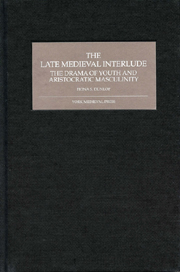Book contents
- Frontmatter
- Contents
- Dedication
- Acknowledgements
- List of Abbreviations
- Introduction: The interlude as a literary genre
- 1 Defining Youth
- 2 Young Masculinity and Late Medieval Discourses of Youth
- 3 Noble Masculinity in the Interludes
- 4 Interludes and the Politics of Youth
- Conclusion
- Bibliography
- Index
- YORK MEDIEVAL PRESS: PUBLICATIONS
Introduction: The interlude as a literary genre
Published online by Cambridge University Press: 05 February 2013
- Frontmatter
- Contents
- Dedication
- Acknowledgements
- List of Abbreviations
- Introduction: The interlude as a literary genre
- 1 Defining Youth
- 2 Young Masculinity and Late Medieval Discourses of Youth
- 3 Noble Masculinity in the Interludes
- 4 Interludes and the Politics of Youth
- Conclusion
- Bibliography
- Index
- YORK MEDIEVAL PRESS: PUBLICATIONS
Summary
The end of the fifteenth century has long been perceived by scholars of literature and history as a crucial turning point – as the frontier between the ‘medieval’ and ‘modern’. This period of transition has been associated with political and administrative innovation, religious Reformation and literary Renaissance: in other words, with new modes of thinking about the self, society and the nation. Many scholars of the early modern period have explored the connections between the development of concepts of individuality and the development of the commercial theatre in the late sixteenth century. According to them, a new kind of drama instigated a new awareness that aspects of the self might be put on or performed, as an actor adopts a role for an audience. In the influential Renaissance Self-Fashioning, recently reissued in a new edition, Stephen Greenblatt first drew attention to metaphors drawn from theatre and spectacle in the work of Thomas More and others which indicate a self-conscious awareness of acting out an identity for the benefit of an audience. Frank Whigham has also discussed the elaborate performances of Elizabethan courtiers who carefully turned out gestures and costumes in order to project finely tuned images of themselves. Building on this work, David Posner has explored the ‘link between theatricality and ideas of nobility and courtly behaviour in the late Renaissance’ amongst nobles driven by an ‘imperative of display’. In turn, Peter Womack saw the commercial theatre of the late sixteenth century as instrumental in the renegotiation of concepts of the nation and the individual's relationship to it, as the theatre takes on a key role in the ‘imagining’ of a much greater body politic.
- Type
- Chapter
- Information
- The Late Medieval InterludeThe Drama of Youth and Aristocratic Masculinity, pp. 1 - 8Publisher: Boydell & BrewerPrint publication year: 2007



